Pedagogical Principles
VerifiedAdded on 2023/03/30
|13
|3191
|52
AI Summary
This document discusses the pedagogical principles of Piaget, Brunner, Skinner, Kounin, and Johari. It explores the effectiveness of creative and innovative approaches in education and explains the VARK model. The document also discusses Skinner's operant conditioning theory, Kounin's theory of classroom management, and Johari's theory of self-awareness. It concludes with an exploration of the relation of cognitivism, behaviorism, humanism, and constructivism to pedagogy and andragogy.
Contribute Materials
Your contribution can guide someone’s learning journey. Share your
documents today.
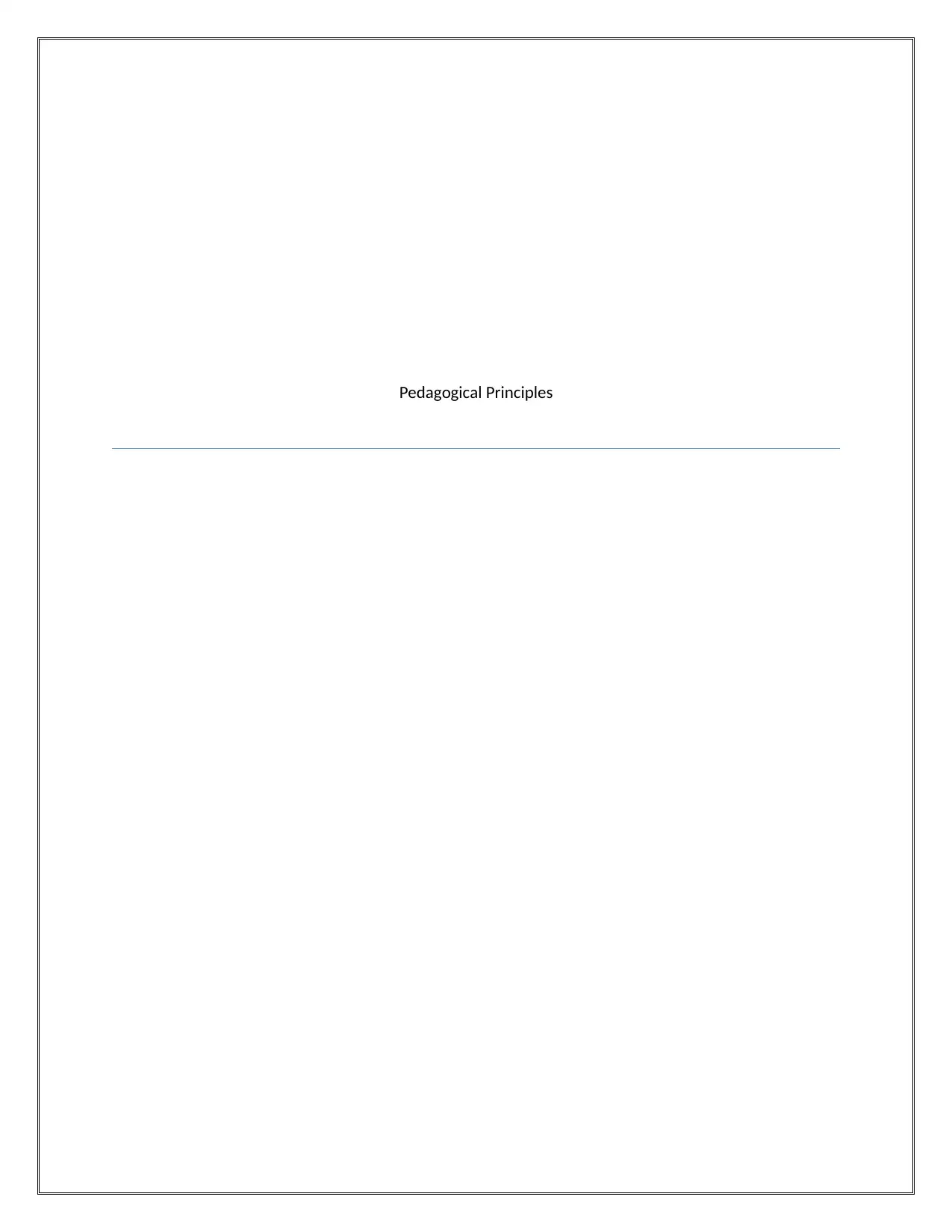
Pedagogical Principles
Secure Best Marks with AI Grader
Need help grading? Try our AI Grader for instant feedback on your assignments.
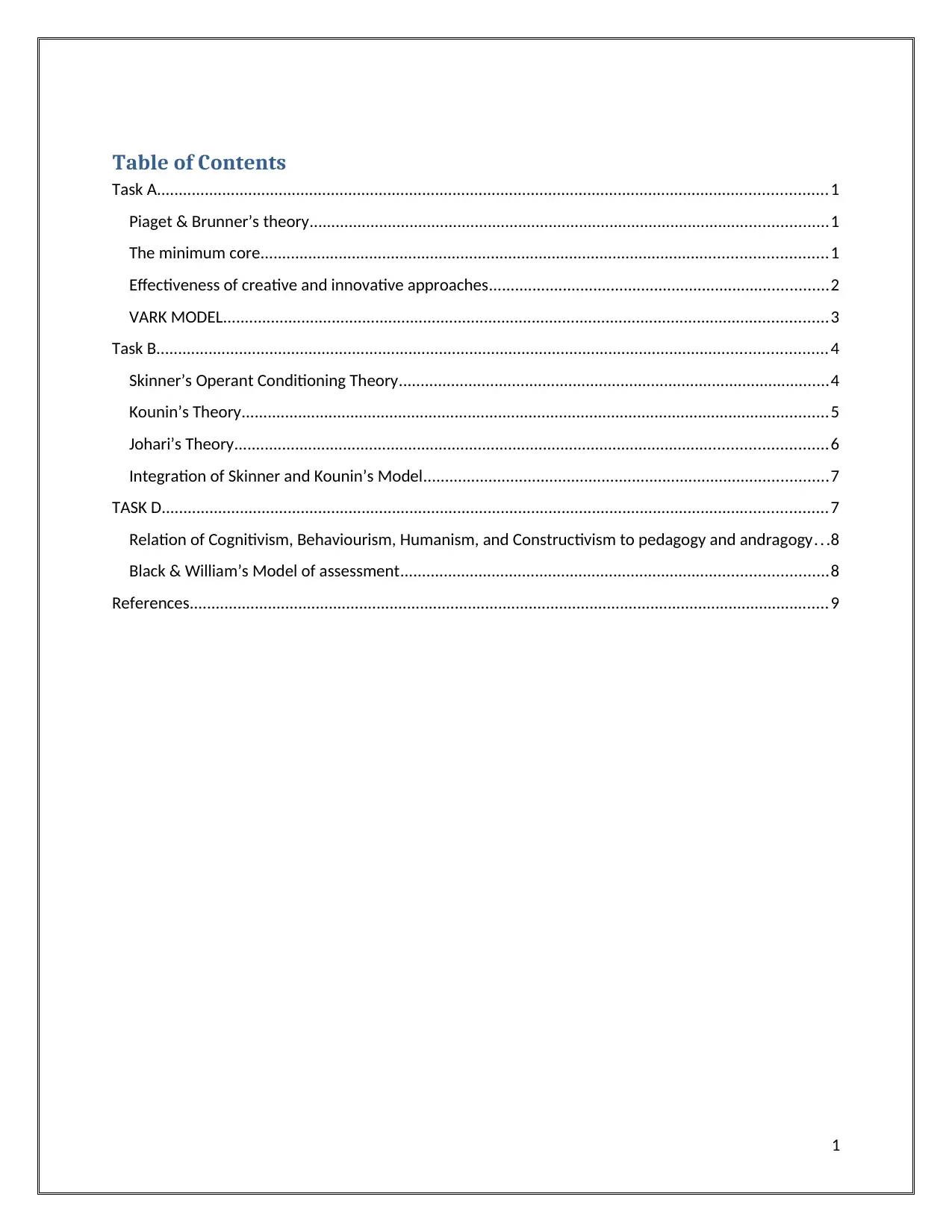
Table of Contents
Task A..........................................................................................................................................................1
Piaget & Brunner’s theory.......................................................................................................................1
The minimum core..................................................................................................................................1
Effectiveness of creative and innovative approaches..............................................................................2
VARK MODEL...........................................................................................................................................3
Task B..........................................................................................................................................................4
Skinner’s Operant Conditioning Theory...................................................................................................4
Kounin’s Theory.......................................................................................................................................5
Johari’s Theory........................................................................................................................................6
Integration of Skinner and Kounin’s Model.............................................................................................7
TASK D.........................................................................................................................................................7
Relation of Cognitivism, Behaviourism, Humanism, and Constructivism to pedagogy and andragogy. . .8
Black & William’s Model of assessment..................................................................................................8
References...................................................................................................................................................9
1
Task A..........................................................................................................................................................1
Piaget & Brunner’s theory.......................................................................................................................1
The minimum core..................................................................................................................................1
Effectiveness of creative and innovative approaches..............................................................................2
VARK MODEL...........................................................................................................................................3
Task B..........................................................................................................................................................4
Skinner’s Operant Conditioning Theory...................................................................................................4
Kounin’s Theory.......................................................................................................................................5
Johari’s Theory........................................................................................................................................6
Integration of Skinner and Kounin’s Model.............................................................................................7
TASK D.........................................................................................................................................................7
Relation of Cognitivism, Behaviourism, Humanism, and Constructivism to pedagogy and andragogy. . .8
Black & William’s Model of assessment..................................................................................................8
References...................................................................................................................................................9
1
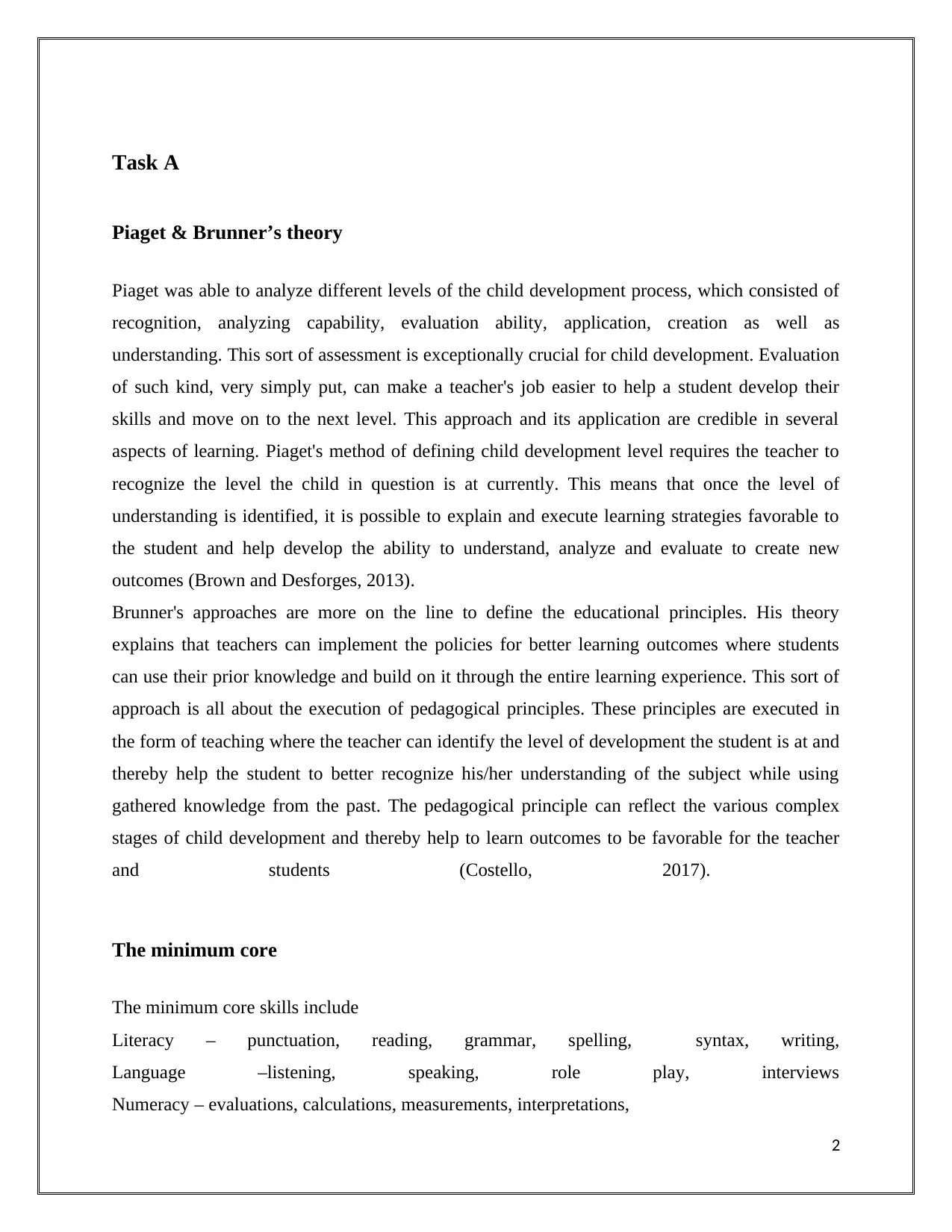
Task A
Piaget & Brunner’s theory
Piaget was able to analyze different levels of the child development process, which consisted of
recognition, analyzing capability, evaluation ability, application, creation as well as
understanding. This sort of assessment is exceptionally crucial for child development. Evaluation
of such kind, very simply put, can make a teacher's job easier to help a student develop their
skills and move on to the next level. This approach and its application are credible in several
aspects of learning. Piaget's method of defining child development level requires the teacher to
recognize the level the child in question is at currently. This means that once the level of
understanding is identified, it is possible to explain and execute learning strategies favorable to
the student and help develop the ability to understand, analyze and evaluate to create new
outcomes (Brown and Desforges, 2013).
Brunner's approaches are more on the line to define the educational principles. His theory
explains that teachers can implement the policies for better learning outcomes where students
can use their prior knowledge and build on it through the entire learning experience. This sort of
approach is all about the execution of pedagogical principles. These principles are executed in
the form of teaching where the teacher can identify the level of development the student is at and
thereby help the student to better recognize his/her understanding of the subject while using
gathered knowledge from the past. The pedagogical principle can reflect the various complex
stages of child development and thereby help to learn outcomes to be favorable for the teacher
and students (Costello, 2017).
The minimum core
The minimum core skills include
Literacy – punctuation, reading, grammar, spelling, syntax, writing,
Language –listening, speaking, role play, interviews
Numeracy – evaluations, calculations, measurements, interpretations,
2
Piaget & Brunner’s theory
Piaget was able to analyze different levels of the child development process, which consisted of
recognition, analyzing capability, evaluation ability, application, creation as well as
understanding. This sort of assessment is exceptionally crucial for child development. Evaluation
of such kind, very simply put, can make a teacher's job easier to help a student develop their
skills and move on to the next level. This approach and its application are credible in several
aspects of learning. Piaget's method of defining child development level requires the teacher to
recognize the level the child in question is at currently. This means that once the level of
understanding is identified, it is possible to explain and execute learning strategies favorable to
the student and help develop the ability to understand, analyze and evaluate to create new
outcomes (Brown and Desforges, 2013).
Brunner's approaches are more on the line to define the educational principles. His theory
explains that teachers can implement the policies for better learning outcomes where students
can use their prior knowledge and build on it through the entire learning experience. This sort of
approach is all about the execution of pedagogical principles. These principles are executed in
the form of teaching where the teacher can identify the level of development the student is at and
thereby help the student to better recognize his/her understanding of the subject while using
gathered knowledge from the past. The pedagogical principle can reflect the various complex
stages of child development and thereby help to learn outcomes to be favorable for the teacher
and students (Costello, 2017).
The minimum core
The minimum core skills include
Literacy – punctuation, reading, grammar, spelling, syntax, writing,
Language –listening, speaking, role play, interviews
Numeracy – evaluations, calculations, measurements, interpretations,
2
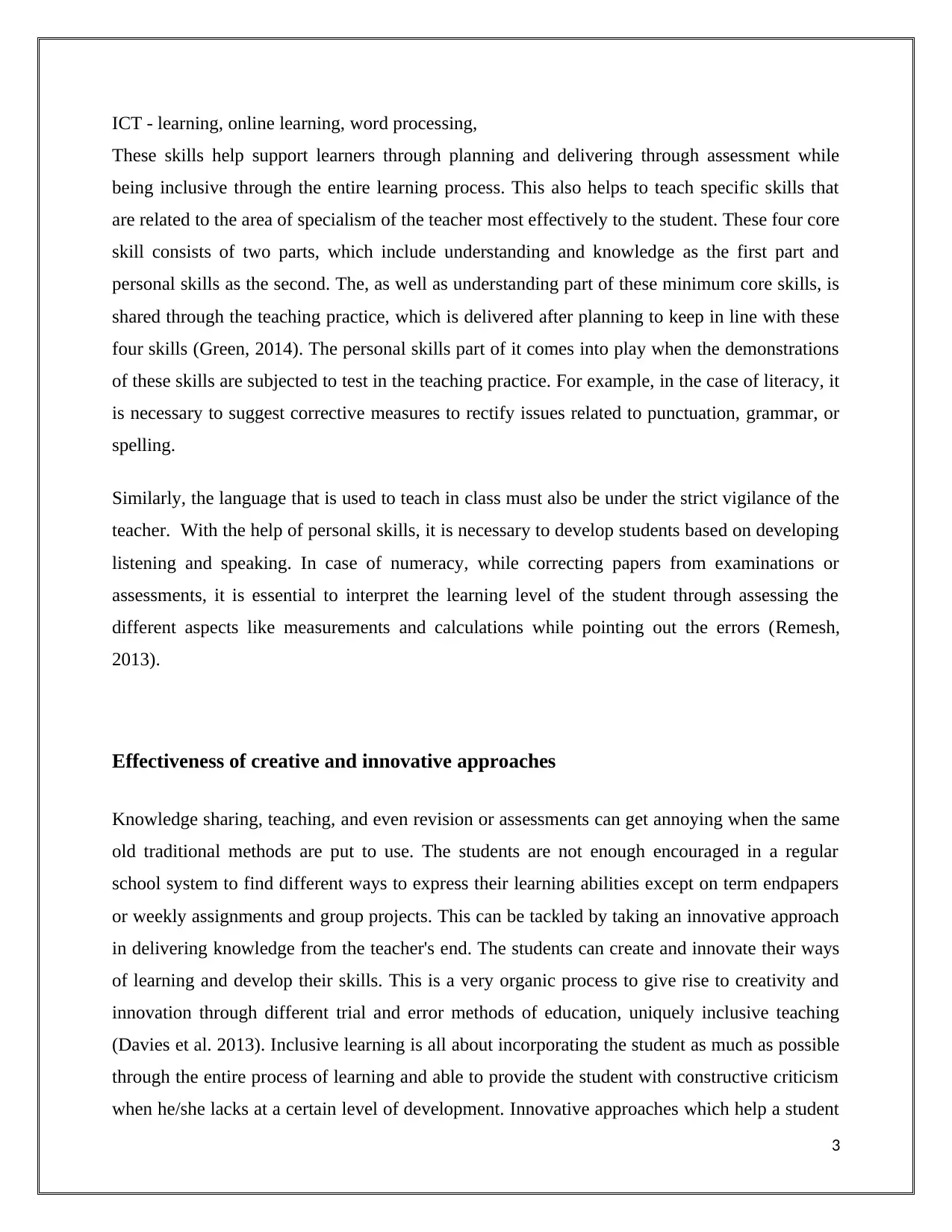
ICT - learning, online learning, word processing,
These skills help support learners through planning and delivering through assessment while
being inclusive through the entire learning process. This also helps to teach specific skills that
are related to the area of specialism of the teacher most effectively to the student. These four core
skill consists of two parts, which include understanding and knowledge as the first part and
personal skills as the second. The, as well as understanding part of these minimum core skills, is
shared through the teaching practice, which is delivered after planning to keep in line with these
four skills (Green, 2014). The personal skills part of it comes into play when the demonstrations
of these skills are subjected to test in the teaching practice. For example, in the case of literacy, it
is necessary to suggest corrective measures to rectify issues related to punctuation, grammar, or
spelling.
Similarly, the language that is used to teach in class must also be under the strict vigilance of the
teacher. With the help of personal skills, it is necessary to develop students based on developing
listening and speaking. In case of numeracy, while correcting papers from examinations or
assessments, it is essential to interpret the learning level of the student through assessing the
different aspects like measurements and calculations while pointing out the errors (Remesh,
2013).
Effectiveness of creative and innovative approaches
Knowledge sharing, teaching, and even revision or assessments can get annoying when the same
old traditional methods are put to use. The students are not enough encouraged in a regular
school system to find different ways to express their learning abilities except on term endpapers
or weekly assignments and group projects. This can be tackled by taking an innovative approach
in delivering knowledge from the teacher's end. The students can create and innovate their ways
of learning and develop their skills. This is a very organic process to give rise to creativity and
innovation through different trial and error methods of education, uniquely inclusive teaching
(Davies et al. 2013). Inclusive learning is all about incorporating the student as much as possible
through the entire process of learning and able to provide the student with constructive criticism
when he/she lacks at a certain level of development. Innovative approaches which help a student
3
These skills help support learners through planning and delivering through assessment while
being inclusive through the entire learning process. This also helps to teach specific skills that
are related to the area of specialism of the teacher most effectively to the student. These four core
skill consists of two parts, which include understanding and knowledge as the first part and
personal skills as the second. The, as well as understanding part of these minimum core skills, is
shared through the teaching practice, which is delivered after planning to keep in line with these
four skills (Green, 2014). The personal skills part of it comes into play when the demonstrations
of these skills are subjected to test in the teaching practice. For example, in the case of literacy, it
is necessary to suggest corrective measures to rectify issues related to punctuation, grammar, or
spelling.
Similarly, the language that is used to teach in class must also be under the strict vigilance of the
teacher. With the help of personal skills, it is necessary to develop students based on developing
listening and speaking. In case of numeracy, while correcting papers from examinations or
assessments, it is essential to interpret the learning level of the student through assessing the
different aspects like measurements and calculations while pointing out the errors (Remesh,
2013).
Effectiveness of creative and innovative approaches
Knowledge sharing, teaching, and even revision or assessments can get annoying when the same
old traditional methods are put to use. The students are not enough encouraged in a regular
school system to find different ways to express their learning abilities except on term endpapers
or weekly assignments and group projects. This can be tackled by taking an innovative approach
in delivering knowledge from the teacher's end. The students can create and innovate their ways
of learning and develop their skills. This is a very organic process to give rise to creativity and
innovation through different trial and error methods of education, uniquely inclusive teaching
(Davies et al. 2013). Inclusive learning is all about incorporating the student as much as possible
through the entire process of learning and able to provide the student with constructive criticism
when he/she lacks at a certain level of development. Innovative approaches which help a student
3
Secure Best Marks with AI Grader
Need help grading? Try our AI Grader for instant feedback on your assignments.
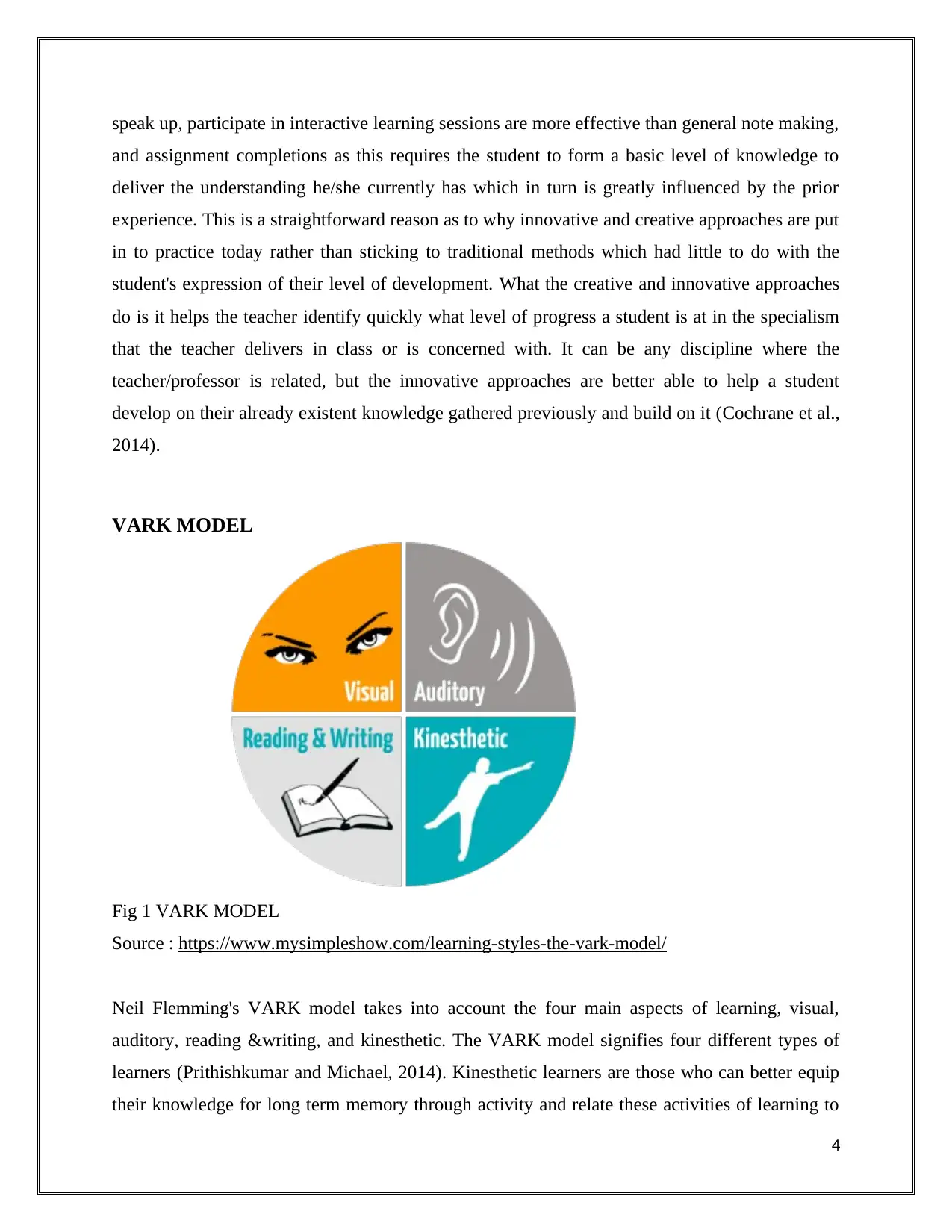
speak up, participate in interactive learning sessions are more effective than general note making,
and assignment completions as this requires the student to form a basic level of knowledge to
deliver the understanding he/she currently has which in turn is greatly influenced by the prior
experience. This is a straightforward reason as to why innovative and creative approaches are put
in to practice today rather than sticking to traditional methods which had little to do with the
student's expression of their level of development. What the creative and innovative approaches
do is it helps the teacher identify quickly what level of progress a student is at in the specialism
that the teacher delivers in class or is concerned with. It can be any discipline where the
teacher/professor is related, but the innovative approaches are better able to help a student
develop on their already existent knowledge gathered previously and build on it (Cochrane et al.,
2014).
VARK MODEL
Fig 1 VARK MODEL
Source : https://www.mysimpleshow.com/learning-styles-the-vark-model/
Neil Flemming's VARK model takes into account the four main aspects of learning, visual,
auditory, reading &writing, and kinesthetic. The VARK model signifies four different types of
learners (Prithishkumar and Michael, 2014). Kinesthetic learners are those who can better equip
their knowledge for long term memory through activity and relate these activities of learning to
4
and assignment completions as this requires the student to form a basic level of knowledge to
deliver the understanding he/she currently has which in turn is greatly influenced by the prior
experience. This is a straightforward reason as to why innovative and creative approaches are put
in to practice today rather than sticking to traditional methods which had little to do with the
student's expression of their level of development. What the creative and innovative approaches
do is it helps the teacher identify quickly what level of progress a student is at in the specialism
that the teacher delivers in class or is concerned with. It can be any discipline where the
teacher/professor is related, but the innovative approaches are better able to help a student
develop on their already existent knowledge gathered previously and build on it (Cochrane et al.,
2014).
VARK MODEL
Fig 1 VARK MODEL
Source : https://www.mysimpleshow.com/learning-styles-the-vark-model/
Neil Flemming's VARK model takes into account the four main aspects of learning, visual,
auditory, reading &writing, and kinesthetic. The VARK model signifies four different types of
learners (Prithishkumar and Michael, 2014). Kinesthetic learners are those who can better equip
their knowledge for long term memory through activity and relate these activities of learning to
4
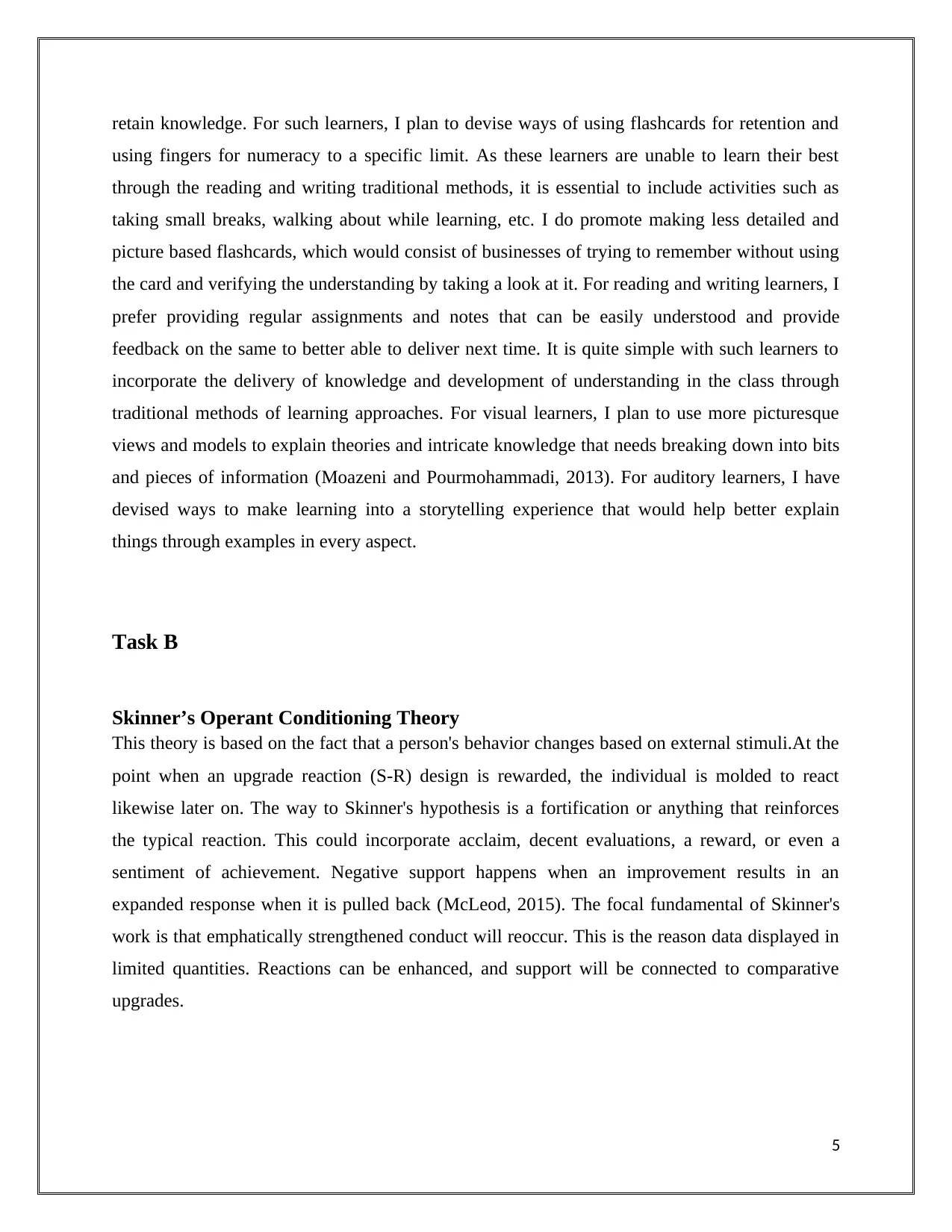
retain knowledge. For such learners, I plan to devise ways of using flashcards for retention and
using fingers for numeracy to a specific limit. As these learners are unable to learn their best
through the reading and writing traditional methods, it is essential to include activities such as
taking small breaks, walking about while learning, etc. I do promote making less detailed and
picture based flashcards, which would consist of businesses of trying to remember without using
the card and verifying the understanding by taking a look at it. For reading and writing learners, I
prefer providing regular assignments and notes that can be easily understood and provide
feedback on the same to better able to deliver next time. It is quite simple with such learners to
incorporate the delivery of knowledge and development of understanding in the class through
traditional methods of learning approaches. For visual learners, I plan to use more picturesque
views and models to explain theories and intricate knowledge that needs breaking down into bits
and pieces of information (Moazeni and Pourmohammadi, 2013). For auditory learners, I have
devised ways to make learning into a storytelling experience that would help better explain
things through examples in every aspect.
Task B
Skinner’s Operant Conditioning Theory
This theory is based on the fact that a person's behavior changes based on external stimuli.At the
point when an upgrade reaction (S-R) design is rewarded, the individual is molded to react
likewise later on. The way to Skinner's hypothesis is a fortification or anything that reinforces
the typical reaction. This could incorporate acclaim, decent evaluations, a reward, or even a
sentiment of achievement. Negative support happens when an improvement results in an
expanded response when it is pulled back (McLeod, 2015). The focal fundamental of Skinner's
work is that emphatically strengthened conduct will reoccur. This is the reason data displayed in
limited quantities. Reactions can be enhanced, and support will be connected to comparative
upgrades.
5
using fingers for numeracy to a specific limit. As these learners are unable to learn their best
through the reading and writing traditional methods, it is essential to include activities such as
taking small breaks, walking about while learning, etc. I do promote making less detailed and
picture based flashcards, which would consist of businesses of trying to remember without using
the card and verifying the understanding by taking a look at it. For reading and writing learners, I
prefer providing regular assignments and notes that can be easily understood and provide
feedback on the same to better able to deliver next time. It is quite simple with such learners to
incorporate the delivery of knowledge and development of understanding in the class through
traditional methods of learning approaches. For visual learners, I plan to use more picturesque
views and models to explain theories and intricate knowledge that needs breaking down into bits
and pieces of information (Moazeni and Pourmohammadi, 2013). For auditory learners, I have
devised ways to make learning into a storytelling experience that would help better explain
things through examples in every aspect.
Task B
Skinner’s Operant Conditioning Theory
This theory is based on the fact that a person's behavior changes based on external stimuli.At the
point when an upgrade reaction (S-R) design is rewarded, the individual is molded to react
likewise later on. The way to Skinner's hypothesis is a fortification or anything that reinforces
the typical reaction. This could incorporate acclaim, decent evaluations, a reward, or even a
sentiment of achievement. Negative support happens when an improvement results in an
expanded response when it is pulled back (McLeod, 2015). The focal fundamental of Skinner's
work is that emphatically strengthened conduct will reoccur. This is the reason data displayed in
limited quantities. Reactions can be enhanced, and support will be connected to comparative
upgrades.
5
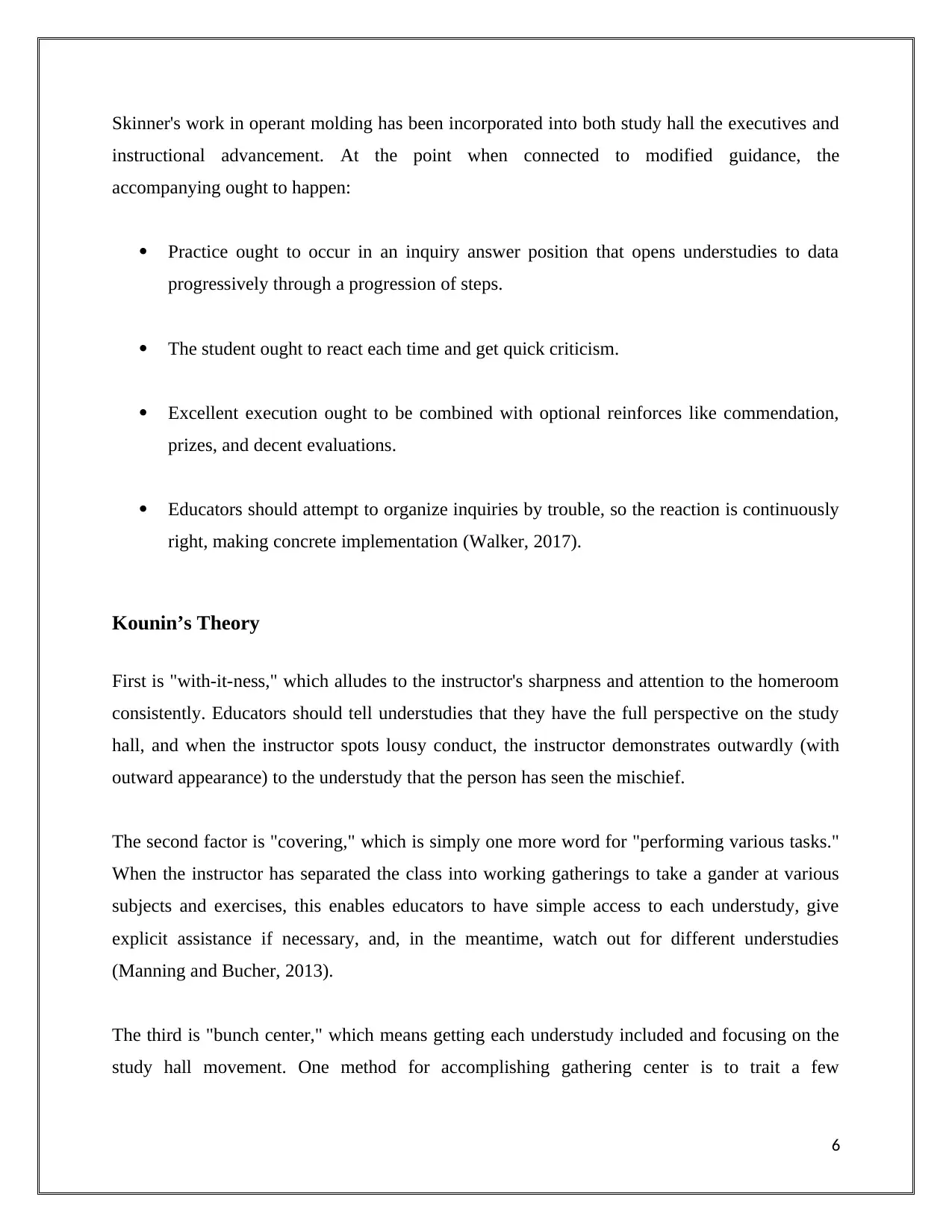
Skinner's work in operant molding has been incorporated into both study hall the executives and
instructional advancement. At the point when connected to modified guidance, the
accompanying ought to happen:
Practice ought to occur in an inquiry answer position that opens understudies to data
progressively through a progression of steps.
The student ought to react each time and get quick criticism.
Excellent execution ought to be combined with optional reinforces like commendation,
prizes, and decent evaluations.
Educators should attempt to organize inquiries by trouble, so the reaction is continuously
right, making concrete implementation (Walker, 2017).
Kounin’s Theory
First is "with-it-ness," which alludes to the instructor's sharpness and attention to the homeroom
consistently. Educators should tell understudies that they have the full perspective on the study
hall, and when the instructor spots lousy conduct, the instructor demonstrates outwardly (with
outward appearance) to the understudy that the person has seen the mischief.
The second factor is "covering," which is simply one more word for "performing various tasks."
When the instructor has separated the class into working gatherings to take a gander at various
subjects and exercises, this enables educators to have simple access to each understudy, give
explicit assistance if necessary, and, in the meantime, watch out for different understudies
(Manning and Bucher, 2013).
The third is "bunch center," which means getting each understudy included and focusing on the
study hall movement. One method for accomplishing gathering center is to trait a few
6
instructional advancement. At the point when connected to modified guidance, the
accompanying ought to happen:
Practice ought to occur in an inquiry answer position that opens understudies to data
progressively through a progression of steps.
The student ought to react each time and get quick criticism.
Excellent execution ought to be combined with optional reinforces like commendation,
prizes, and decent evaluations.
Educators should attempt to organize inquiries by trouble, so the reaction is continuously
right, making concrete implementation (Walker, 2017).
Kounin’s Theory
First is "with-it-ness," which alludes to the instructor's sharpness and attention to the homeroom
consistently. Educators should tell understudies that they have the full perspective on the study
hall, and when the instructor spots lousy conduct, the instructor demonstrates outwardly (with
outward appearance) to the understudy that the person has seen the mischief.
The second factor is "covering," which is simply one more word for "performing various tasks."
When the instructor has separated the class into working gatherings to take a gander at various
subjects and exercises, this enables educators to have simple access to each understudy, give
explicit assistance if necessary, and, in the meantime, watch out for different understudies
(Manning and Bucher, 2013).
The third is "bunch center," which means getting each understudy included and focusing on the
study hall movement. One method for accomplishing gathering center is to trait a few
6
Paraphrase This Document
Need a fresh take? Get an instant paraphrase of this document with our AI Paraphraser
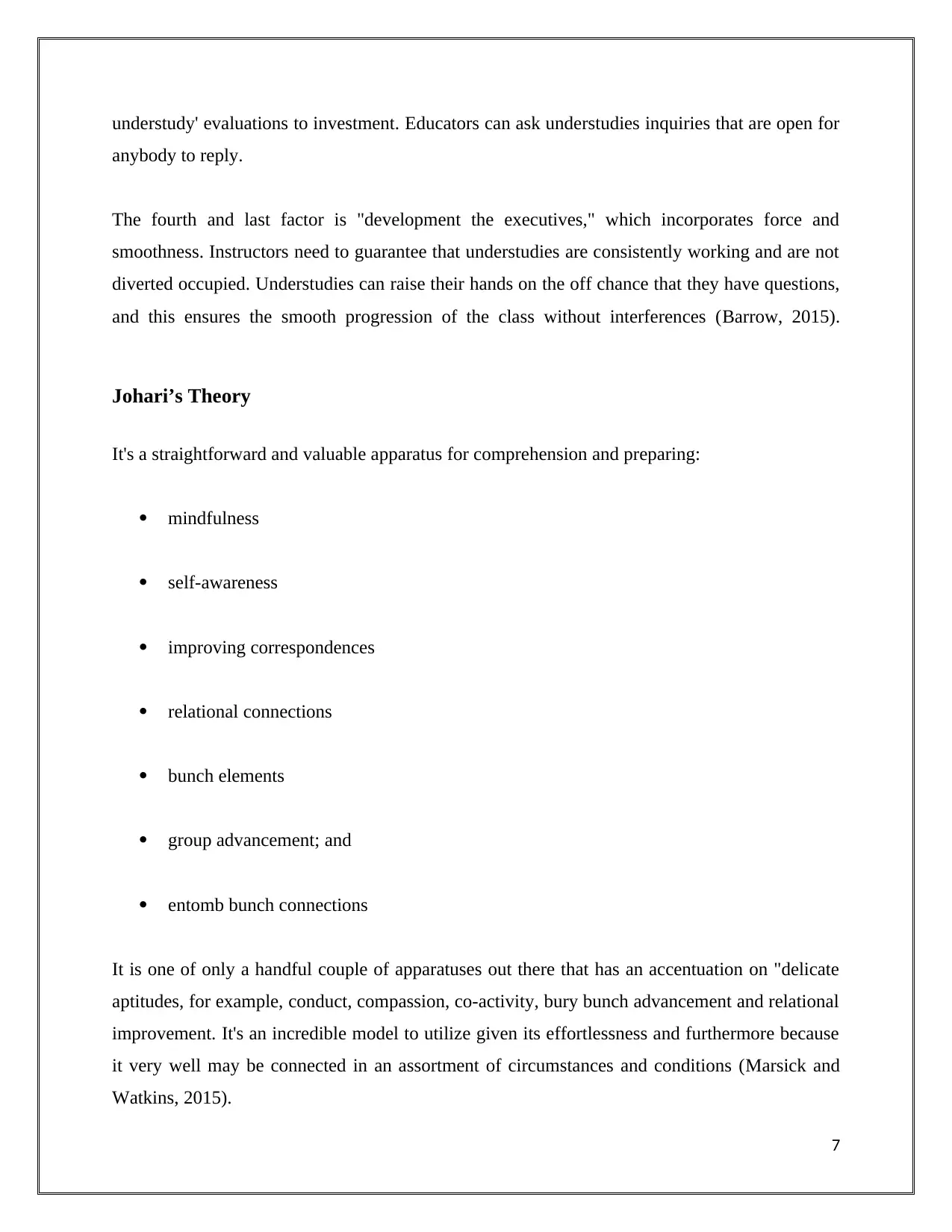
understudy' evaluations to investment. Educators can ask understudies inquiries that are open for
anybody to reply.
The fourth and last factor is "development the executives," which incorporates force and
smoothness. Instructors need to guarantee that understudies are consistently working and are not
diverted occupied. Understudies can raise their hands on the off chance that they have questions,
and this ensures the smooth progression of the class without interferences (Barrow, 2015).
Johari’s Theory
It's a straightforward and valuable apparatus for comprehension and preparing:
mindfulness
self-awareness
improving correspondences
relational connections
bunch elements
group advancement; and
entomb bunch connections
It is one of only a handful couple of apparatuses out there that has an accentuation on "delicate
aptitudes, for example, conduct, compassion, co-activity, bury bunch advancement and relational
improvement. It's an incredible model to utilize given its effortlessness and furthermore because
it very well may be connected in an assortment of circumstances and conditions (Marsick and
Watkins, 2015).
7
anybody to reply.
The fourth and last factor is "development the executives," which incorporates force and
smoothness. Instructors need to guarantee that understudies are consistently working and are not
diverted occupied. Understudies can raise their hands on the off chance that they have questions,
and this ensures the smooth progression of the class without interferences (Barrow, 2015).
Johari’s Theory
It's a straightforward and valuable apparatus for comprehension and preparing:
mindfulness
self-awareness
improving correspondences
relational connections
bunch elements
group advancement; and
entomb bunch connections
It is one of only a handful couple of apparatuses out there that has an accentuation on "delicate
aptitudes, for example, conduct, compassion, co-activity, bury bunch advancement and relational
improvement. It's an incredible model to utilize given its effortlessness and furthermore because
it very well may be connected in an assortment of circumstances and conditions (Marsick and
Watkins, 2015).
7

Integration of Skinner and Kounin’s Model
In terms of behavior management, Skinner's theory is all about practical approaches for positive
reinforcements. It is based on the fact that an individual's response to certain stimuli can be
useful in learning approach through positive reinforcements. I see this as an excellent method to
incorporate positive strategies in learning and the rewarding system. I plan to break every session
through questioning and upon receiving an answer for the discussed topics provide the student
with positive affirmations that would initiate a response and encourage the student to respond
similarly in the future. Even in cases when the answer received is wrong I do not plan to move
on to the next student without helping the previous one to understand where he/she went crazy,
instead I try to influence and provide hints for the correct answer once received and provide
similar words of positive criticism that wouldn't discourage the student from answering next time
(Surif et al., 2013).
Through Kounin's approach of classroom behavior management, firstly with the with-it-ness
approach, I ensure that as soon as I enter the classroom, I have a decent view of all those that are
present in the school. I do not encourage in verbal recognition of misconduct as long as it is not
interruptive but merely zoning off of the classroom. In case of grave misconduct, those that are
responsible for it are immediately addressed and are incorporated in the lesson to read out to the
class, which ensures that they are themselves involved even while being disciplined.
TASKD
Cognitivism, Behaviourism, Humanism, and Constructivism
Cognitivism- I try to breakdown big hunks of information into smaller ones and link new
concepts based on old ones. This way, it is easier to relate and retain new content. I plan to
organize my lectures into meaningful parts along with real-world examples. I would also
integrate problem-solving and encourage discussion in the class (Hansen et al., 2014).
8
In terms of behavior management, Skinner's theory is all about practical approaches for positive
reinforcements. It is based on the fact that an individual's response to certain stimuli can be
useful in learning approach through positive reinforcements. I see this as an excellent method to
incorporate positive strategies in learning and the rewarding system. I plan to break every session
through questioning and upon receiving an answer for the discussed topics provide the student
with positive affirmations that would initiate a response and encourage the student to respond
similarly in the future. Even in cases when the answer received is wrong I do not plan to move
on to the next student without helping the previous one to understand where he/she went crazy,
instead I try to influence and provide hints for the correct answer once received and provide
similar words of positive criticism that wouldn't discourage the student from answering next time
(Surif et al., 2013).
Through Kounin's approach of classroom behavior management, firstly with the with-it-ness
approach, I ensure that as soon as I enter the classroom, I have a decent view of all those that are
present in the school. I do not encourage in verbal recognition of misconduct as long as it is not
interruptive but merely zoning off of the classroom. In case of grave misconduct, those that are
responsible for it are immediately addressed and are incorporated in the lesson to read out to the
class, which ensures that they are themselves involved even while being disciplined.
TASKD
Cognitivism, Behaviourism, Humanism, and Constructivism
Cognitivism- I try to breakdown big hunks of information into smaller ones and link new
concepts based on old ones. This way, it is easier to relate and retain new content. I plan to
organize my lectures into meaningful parts along with real-world examples. I would also
integrate problem-solving and encourage discussion in the class (Hansen et al., 2014).
8
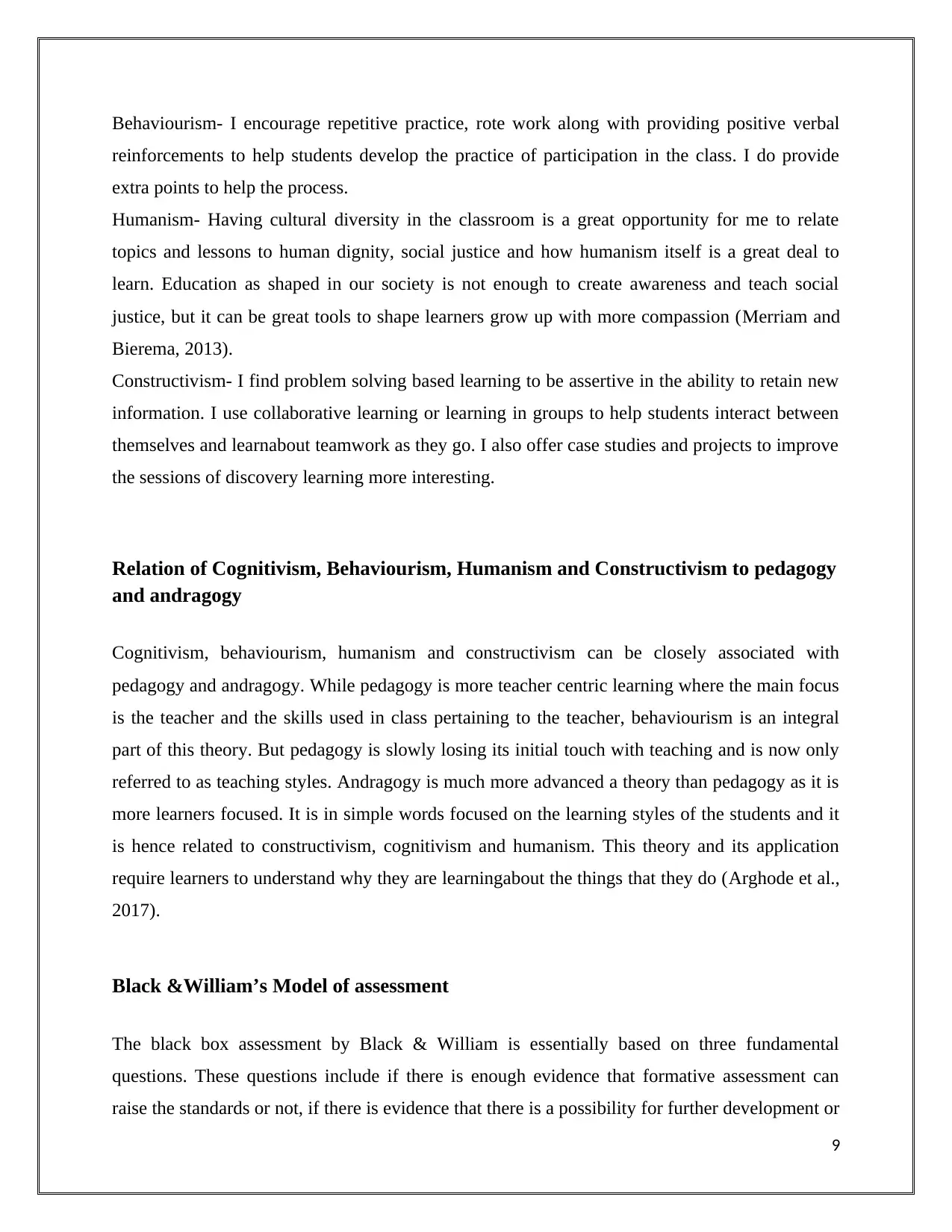
Behaviourism- I encourage repetitive practice, rote work along with providing positive verbal
reinforcements to help students develop the practice of participation in the class. I do provide
extra points to help the process.
Humanism- Having cultural diversity in the classroom is a great opportunity for me to relate
topics and lessons to human dignity, social justice and how humanism itself is a great deal to
learn. Education as shaped in our society is not enough to create awareness and teach social
justice, but it can be great tools to shape learners grow up with more compassion (Merriam and
Bierema, 2013).
Constructivism- I find problem solving based learning to be assertive in the ability to retain new
information. I use collaborative learning or learning in groups to help students interact between
themselves and learnabout teamwork as they go. I also offer case studies and projects to improve
the sessions of discovery learning more interesting.
Relation of Cognitivism, Behaviourism, Humanism and Constructivism to pedagogy
and andragogy
Cognitivism, behaviourism, humanism and constructivism can be closely associated with
pedagogy and andragogy. While pedagogy is more teacher centric learning where the main focus
is the teacher and the skills used in class pertaining to the teacher, behaviourism is an integral
part of this theory. But pedagogy is slowly losing its initial touch with teaching and is now only
referred to as teaching styles. Andragogy is much more advanced a theory than pedagogy as it is
more learners focused. It is in simple words focused on the learning styles of the students and it
is hence related to constructivism, cognitivism and humanism. This theory and its application
require learners to understand why they are learningabout the things that they do (Arghode et al.,
2017).
Black &William’s Model of assessment
The black box assessment by Black & William is essentially based on three fundamental
questions. These questions include if there is enough evidence that formative assessment can
raise the standards or not, if there is evidence that there is a possibility for further development or
9
reinforcements to help students develop the practice of participation in the class. I do provide
extra points to help the process.
Humanism- Having cultural diversity in the classroom is a great opportunity for me to relate
topics and lessons to human dignity, social justice and how humanism itself is a great deal to
learn. Education as shaped in our society is not enough to create awareness and teach social
justice, but it can be great tools to shape learners grow up with more compassion (Merriam and
Bierema, 2013).
Constructivism- I find problem solving based learning to be assertive in the ability to retain new
information. I use collaborative learning or learning in groups to help students interact between
themselves and learnabout teamwork as they go. I also offer case studies and projects to improve
the sessions of discovery learning more interesting.
Relation of Cognitivism, Behaviourism, Humanism and Constructivism to pedagogy
and andragogy
Cognitivism, behaviourism, humanism and constructivism can be closely associated with
pedagogy and andragogy. While pedagogy is more teacher centric learning where the main focus
is the teacher and the skills used in class pertaining to the teacher, behaviourism is an integral
part of this theory. But pedagogy is slowly losing its initial touch with teaching and is now only
referred to as teaching styles. Andragogy is much more advanced a theory than pedagogy as it is
more learners focused. It is in simple words focused on the learning styles of the students and it
is hence related to constructivism, cognitivism and humanism. This theory and its application
require learners to understand why they are learningabout the things that they do (Arghode et al.,
2017).
Black &William’s Model of assessment
The black box assessment by Black & William is essentially based on three fundamental
questions. These questions include if there is enough evidence that formative assessment can
raise the standards or not, if there is evidence that there is a possibility for further development or
9
Secure Best Marks with AI Grader
Need help grading? Try our AI Grader for instant feedback on your assignments.
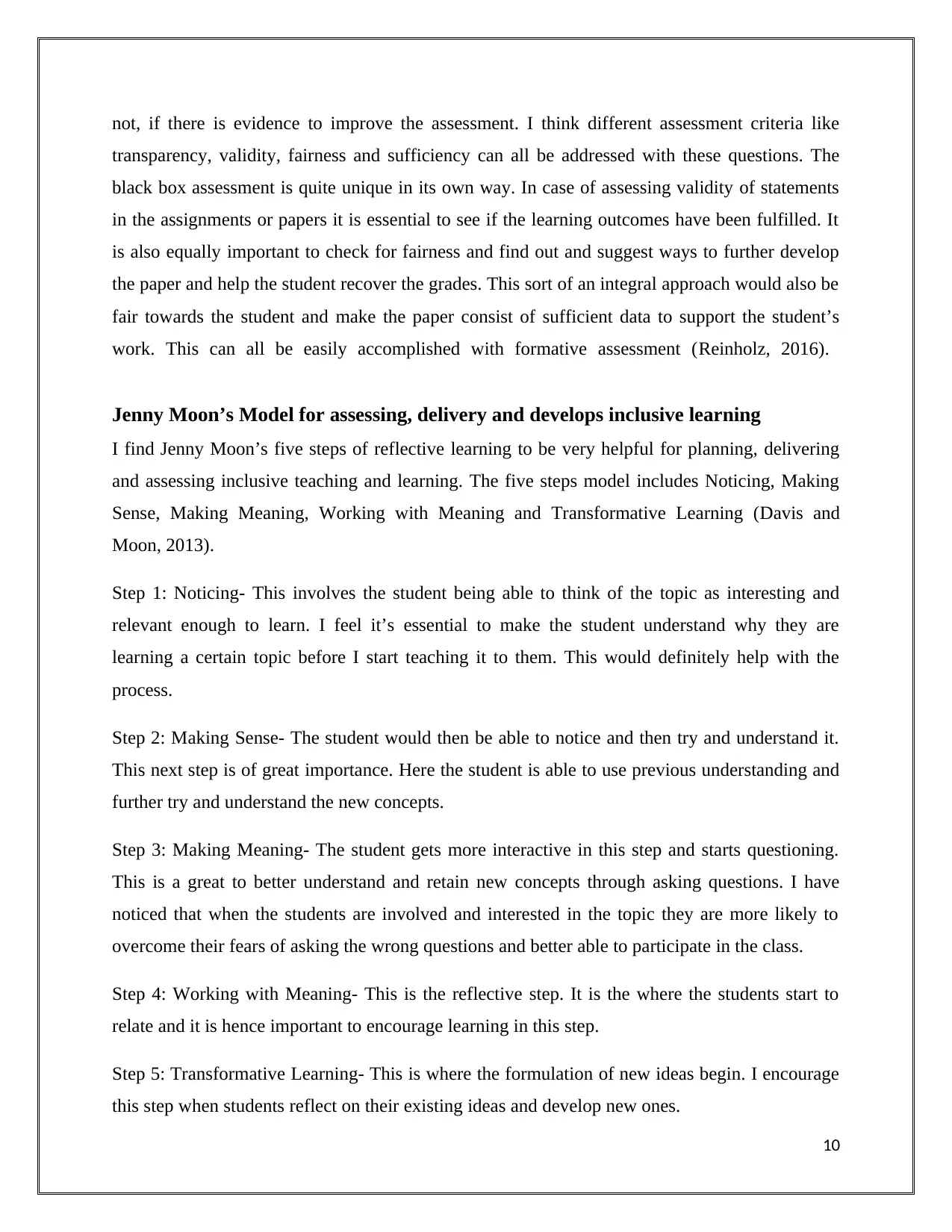
not, if there is evidence to improve the assessment. I think different assessment criteria like
transparency, validity, fairness and sufficiency can all be addressed with these questions. The
black box assessment is quite unique in its own way. In case of assessing validity of statements
in the assignments or papers it is essential to see if the learning outcomes have been fulfilled. It
is also equally important to check for fairness and find out and suggest ways to further develop
the paper and help the student recover the grades. This sort of an integral approach would also be
fair towards the student and make the paper consist of sufficient data to support the student’s
work. This can all be easily accomplished with formative assessment (Reinholz, 2016).
Jenny Moon’s Model for assessing, delivery and develops inclusive learning
I find Jenny Moon’s five steps of reflective learning to be very helpful for planning, delivering
and assessing inclusive teaching and learning. The five steps model includes Noticing, Making
Sense, Making Meaning, Working with Meaning and Transformative Learning (Davis and
Moon, 2013).
Step 1: Noticing- This involves the student being able to think of the topic as interesting and
relevant enough to learn. I feel it’s essential to make the student understand why they are
learning a certain topic before I start teaching it to them. This would definitely help with the
process.
Step 2: Making Sense- The student would then be able to notice and then try and understand it.
This next step is of great importance. Here the student is able to use previous understanding and
further try and understand the new concepts.
Step 3: Making Meaning- The student gets more interactive in this step and starts questioning.
This is a great to better understand and retain new concepts through asking questions. I have
noticed that when the students are involved and interested in the topic they are more likely to
overcome their fears of asking the wrong questions and better able to participate in the class.
Step 4: Working with Meaning- This is the reflective step. It is the where the students start to
relate and it is hence important to encourage learning in this step.
Step 5: Transformative Learning- This is where the formulation of new ideas begin. I encourage
this step when students reflect on their existing ideas and develop new ones.
10
transparency, validity, fairness and sufficiency can all be addressed with these questions. The
black box assessment is quite unique in its own way. In case of assessing validity of statements
in the assignments or papers it is essential to see if the learning outcomes have been fulfilled. It
is also equally important to check for fairness and find out and suggest ways to further develop
the paper and help the student recover the grades. This sort of an integral approach would also be
fair towards the student and make the paper consist of sufficient data to support the student’s
work. This can all be easily accomplished with formative assessment (Reinholz, 2016).
Jenny Moon’s Model for assessing, delivery and develops inclusive learning
I find Jenny Moon’s five steps of reflective learning to be very helpful for planning, delivering
and assessing inclusive teaching and learning. The five steps model includes Noticing, Making
Sense, Making Meaning, Working with Meaning and Transformative Learning (Davis and
Moon, 2013).
Step 1: Noticing- This involves the student being able to think of the topic as interesting and
relevant enough to learn. I feel it’s essential to make the student understand why they are
learning a certain topic before I start teaching it to them. This would definitely help with the
process.
Step 2: Making Sense- The student would then be able to notice and then try and understand it.
This next step is of great importance. Here the student is able to use previous understanding and
further try and understand the new concepts.
Step 3: Making Meaning- The student gets more interactive in this step and starts questioning.
This is a great to better understand and retain new concepts through asking questions. I have
noticed that when the students are involved and interested in the topic they are more likely to
overcome their fears of asking the wrong questions and better able to participate in the class.
Step 4: Working with Meaning- This is the reflective step. It is the where the students start to
relate and it is hence important to encourage learning in this step.
Step 5: Transformative Learning- This is where the formulation of new ideas begin. I encourage
this step when students reflect on their existing ideas and develop new ones.
10
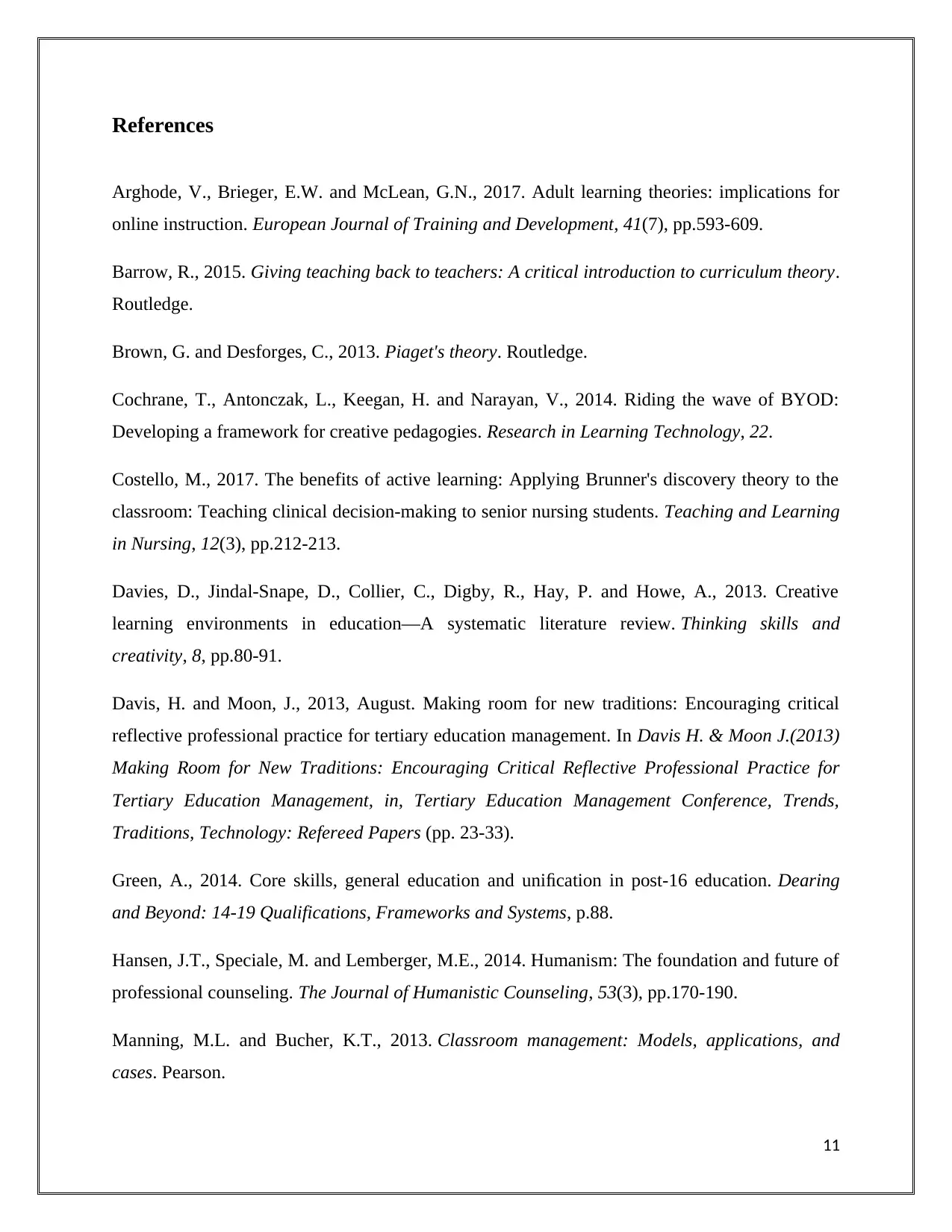
References
Arghode, V., Brieger, E.W. and McLean, G.N., 2017. Adult learning theories: implications for
online instruction. European Journal of Training and Development, 41(7), pp.593-609.
Barrow, R., 2015. Giving teaching back to teachers: A critical introduction to curriculum theory.
Routledge.
Brown, G. and Desforges, C., 2013. Piaget's theory. Routledge.
Cochrane, T., Antonczak, L., Keegan, H. and Narayan, V., 2014. Riding the wave of BYOD:
Developing a framework for creative pedagogies. Research in Learning Technology, 22.
Costello, M., 2017. The benefits of active learning: Applying Brunner's discovery theory to the
classroom: Teaching clinical decision-making to senior nursing students. Teaching and Learning
in Nursing, 12(3), pp.212-213.
Davies, D., Jindal-Snape, D., Collier, C., Digby, R., Hay, P. and Howe, A., 2013. Creative
learning environments in education—A systematic literature review. Thinking skills and
creativity, 8, pp.80-91.
Davis, H. and Moon, J., 2013, August. Making room for new traditions: Encouraging critical
reflective professional practice for tertiary education management. In Davis H. & Moon J.(2013)
Making Room for New Traditions: Encouraging Critical Reflective Professional Practice for
Tertiary Education Management, in, Tertiary Education Management Conference, Trends,
Traditions, Technology: Refereed Papers (pp. 23-33).
Green, A., 2014. Core skills, general education and unification in post-16 education. Dearing
and Beyond: 14-19 Qualifications, Frameworks and Systems, p.88.
Hansen, J.T., Speciale, M. and Lemberger, M.E., 2014. Humanism: The foundation and future of
professional counseling. The Journal of Humanistic Counseling, 53(3), pp.170-190.
Manning, M.L. and Bucher, K.T., 2013. Classroom management: Models, applications, and
cases. Pearson.
11
Arghode, V., Brieger, E.W. and McLean, G.N., 2017. Adult learning theories: implications for
online instruction. European Journal of Training and Development, 41(7), pp.593-609.
Barrow, R., 2015. Giving teaching back to teachers: A critical introduction to curriculum theory.
Routledge.
Brown, G. and Desforges, C., 2013. Piaget's theory. Routledge.
Cochrane, T., Antonczak, L., Keegan, H. and Narayan, V., 2014. Riding the wave of BYOD:
Developing a framework for creative pedagogies. Research in Learning Technology, 22.
Costello, M., 2017. The benefits of active learning: Applying Brunner's discovery theory to the
classroom: Teaching clinical decision-making to senior nursing students. Teaching and Learning
in Nursing, 12(3), pp.212-213.
Davies, D., Jindal-Snape, D., Collier, C., Digby, R., Hay, P. and Howe, A., 2013. Creative
learning environments in education—A systematic literature review. Thinking skills and
creativity, 8, pp.80-91.
Davis, H. and Moon, J., 2013, August. Making room for new traditions: Encouraging critical
reflective professional practice for tertiary education management. In Davis H. & Moon J.(2013)
Making Room for New Traditions: Encouraging Critical Reflective Professional Practice for
Tertiary Education Management, in, Tertiary Education Management Conference, Trends,
Traditions, Technology: Refereed Papers (pp. 23-33).
Green, A., 2014. Core skills, general education and unification in post-16 education. Dearing
and Beyond: 14-19 Qualifications, Frameworks and Systems, p.88.
Hansen, J.T., Speciale, M. and Lemberger, M.E., 2014. Humanism: The foundation and future of
professional counseling. The Journal of Humanistic Counseling, 53(3), pp.170-190.
Manning, M.L. and Bucher, K.T., 2013. Classroom management: Models, applications, and
cases. Pearson.
11
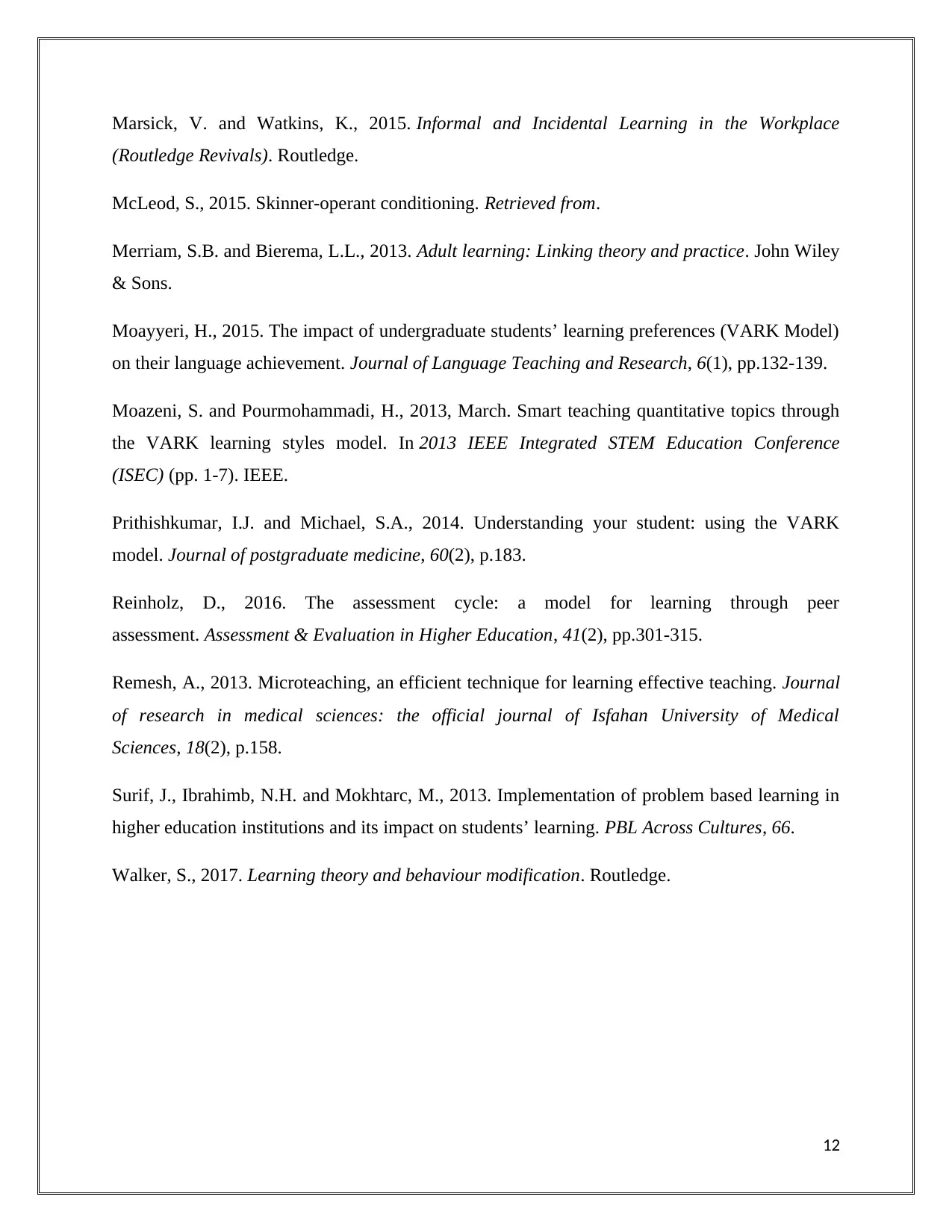
Marsick, V. and Watkins, K., 2015. Informal and Incidental Learning in the Workplace
(Routledge Revivals). Routledge.
McLeod, S., 2015. Skinner-operant conditioning. Retrieved from.
Merriam, S.B. and Bierema, L.L., 2013. Adult learning: Linking theory and practice. John Wiley
& Sons.
Moayyeri, H., 2015. The impact of undergraduate students’ learning preferences (VARK Model)
on their language achievement. Journal of Language Teaching and Research, 6(1), pp.132-139.
Moazeni, S. and Pourmohammadi, H., 2013, March. Smart teaching quantitative topics through
the VARK learning styles model. In 2013 IEEE Integrated STEM Education Conference
(ISEC) (pp. 1-7). IEEE.
Prithishkumar, I.J. and Michael, S.A., 2014. Understanding your student: using the VARK
model. Journal of postgraduate medicine, 60(2), p.183.
Reinholz, D., 2016. The assessment cycle: a model for learning through peer
assessment. Assessment & Evaluation in Higher Education, 41(2), pp.301-315.
Remesh, A., 2013. Microteaching, an efficient technique for learning effective teaching. Journal
of research in medical sciences: the official journal of Isfahan University of Medical
Sciences, 18(2), p.158.
Surif, J., Ibrahimb, N.H. and Mokhtarc, M., 2013. Implementation of problem based learning in
higher education institutions and its impact on students’ learning. PBL Across Cultures, 66.
Walker, S., 2017. Learning theory and behaviour modification. Routledge.
12
(Routledge Revivals). Routledge.
McLeod, S., 2015. Skinner-operant conditioning. Retrieved from.
Merriam, S.B. and Bierema, L.L., 2013. Adult learning: Linking theory and practice. John Wiley
& Sons.
Moayyeri, H., 2015. The impact of undergraduate students’ learning preferences (VARK Model)
on their language achievement. Journal of Language Teaching and Research, 6(1), pp.132-139.
Moazeni, S. and Pourmohammadi, H., 2013, March. Smart teaching quantitative topics through
the VARK learning styles model. In 2013 IEEE Integrated STEM Education Conference
(ISEC) (pp. 1-7). IEEE.
Prithishkumar, I.J. and Michael, S.A., 2014. Understanding your student: using the VARK
model. Journal of postgraduate medicine, 60(2), p.183.
Reinholz, D., 2016. The assessment cycle: a model for learning through peer
assessment. Assessment & Evaluation in Higher Education, 41(2), pp.301-315.
Remesh, A., 2013. Microteaching, an efficient technique for learning effective teaching. Journal
of research in medical sciences: the official journal of Isfahan University of Medical
Sciences, 18(2), p.158.
Surif, J., Ibrahimb, N.H. and Mokhtarc, M., 2013. Implementation of problem based learning in
higher education institutions and its impact on students’ learning. PBL Across Cultures, 66.
Walker, S., 2017. Learning theory and behaviour modification. Routledge.
12
1 out of 13
Related Documents
Your All-in-One AI-Powered Toolkit for Academic Success.
+13062052269
info@desklib.com
Available 24*7 on WhatsApp / Email
![[object Object]](/_next/static/media/star-bottom.7253800d.svg)
Unlock your academic potential
© 2024 | Zucol Services PVT LTD | All rights reserved.





